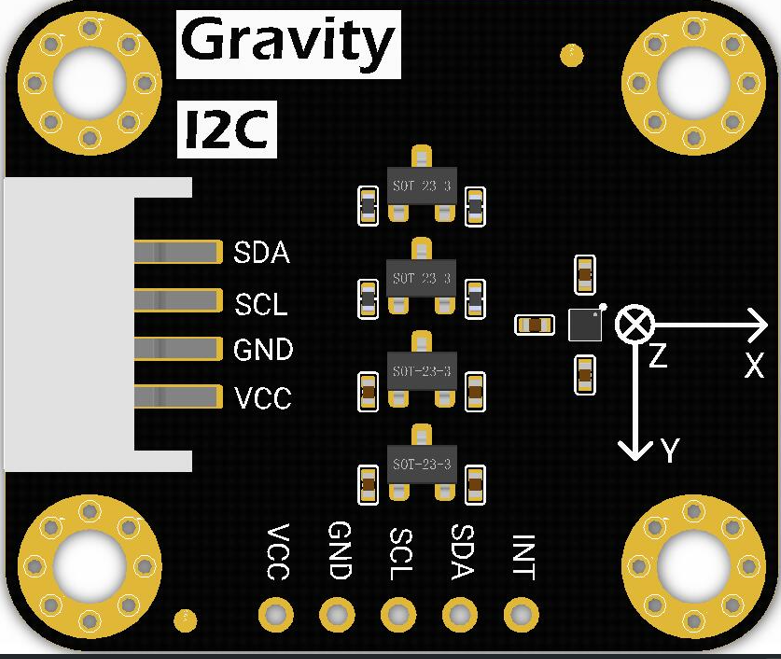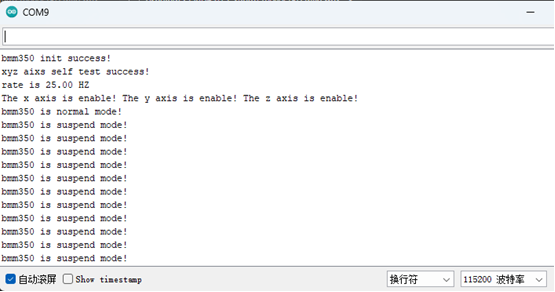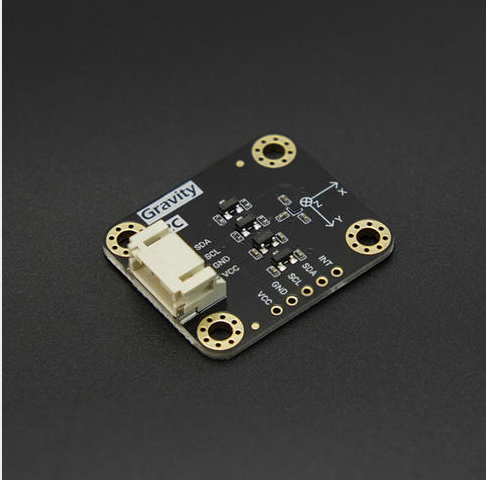1.产品简介
这款BMM350 三轴数字地磁传感器。可测量三个空间轴上的磁场强度,具有低功耗(200uA),低噪声(190nT rms@xy轴 450nT rms@z轴),高量程(±2000μT),高采样率(400~25/16Hz,可选)的特点。
其采用了TMR(隧道磁阻)技术,并具有独特的场冲击恢复功能。此功能使该设备对外部磁场具有很强的鲁棒性,从而在周遭磁场的冲击下始终确保高精度。
可用于室内外导航与定位,电子罗盘,AR/VR设备应用开发。
2.产品特性
-
1个可编程中断引脚
-
低功耗(200uA)
-
低噪声(190nT rms@xy轴 450nT rms@z轴)
-
高量程(±2000μT)
3.应用场景
- 无人机
- 指南针/电子罗盘
- 室内/室外导航
- 头部运动追踪
- 增强现实
- 倾斜补偿的电子地图
4.引脚排列图

| 引脚 | 功能描述 |
|---|---|
| VCC | DC3.3V-5V |
| GND | 接地 |
| SCL | I2C时钟线 |
| SDA | I2C数据线 |
| INT | 中断引脚 |
5.规格参数
- 供电电压:3.3V-5V
- 正常工作温度范围:-40~85°C
- 接口协议:I2C
- 分辨率:0.1uT
- 零度漂移:±40uT/±2uT(软件优化后)
- 非线性:< 1%FS
- 磁力测量范围:±2000μT
- 工作电流:200uA(Normal mode)
- 低噪声:190nT rms@xy轴 450nT rms@z轴
- 精度:30uT水平磁场分量 ±2.5°
- 启动时间:3ms
6.尺寸图

7.使用教程
7.1 硬件准备
-
FireBeetle ESP32-E主控板 (SKU:DFR0654) ×1
-
BMM350三轴磁力计传感器(SKU:SEN0529)×1
-
杜邦线 若干
7.2 软件准备
- 下载Arduino IDE: 点击下载Arduino IDE
- 安装SDK:点击进入FireBeetle ESP32-E主控板 WIKI页面 查找SDK安装教程
- 下载Arduino库:DFRobot_BMM350库文件下载,
- 关于如何安装库文件: 如何加载库文件
7.3 硬件连接

Gravity I2C BMM350模块:VCC---(连接)---ESP32-E主控:3V3;
Gravity I2C BMM350模块:GND---(连接)---ESP32-E主控:GND;
Gravity I2C BMM350模块:SCL---(连接)---ESP32-E主控:SCL;
Gravity I2C BMM350模块:SDA---(连接)---ESP32-E主控:SDA;
7.4 演示代码
样例代码
- 样例代码1-获取配置状态(getAllState.ino)
- 样例代码2-获取三轴地磁数据、罗盘角度(getGeomagneticData.ino)
- 样例代码3-阈值中断功能(thresholdInterrupt.ino)
样例代码1-获取配置状态(getAllState.ino)
- 烧录程序
/*!
* @file getAllState.ino
* @brief Get all the config status, self test status; the sensor turns to sleep mode from normal mode after reset
* @n Experimental phenomenon: serial print the sensor config information and the self-test information
* @copyright Copyright (c) 2010 DFRobot Co.Ltd (http://www.dfrobot.com)
* @license The MIT License (MIT)
* @author [GDuang](yonglei.ren@dfrobot.com)
* @version V1.0.0
* @date 2024-05-06
* @url https://github.com/dfrobot/DFRobot_BMM350
*/
#include "DFRobot_BMM350.h"
DFRobot_BMM350_I2C bmm350(&Wire, 0x14);
void setup()
{
Serial.begin(115200);
while(!Serial);
while(bmm350.begin()){
Serial.println("bmm350 init failed, Please try again!");
delay(1000);
} Serial.println("bmm350 init success!");
/**!
* 传感器自检,返回字符串表示自检结果
*/
Serial.println(bmm350.selfTest());
/**!
* 设置传感器运行模式
* opMode:
* BMM350_SUSPEND_MODE // suspend mode: Suspend mode is the default power mode of BMM350 after the chip is powered, Current consumption in suspend mode is minimal,
* so, this mode is useful for periods when data conversion is not needed. Read and write of all registers is possible.
* BMM350_NORMAL_MODE // normal mode Get geomagnetic data normally.
* BMM350_FORCED_MODE // forced mode Single measurement, the sensor restores to suspend mode when the measurement is done.
* BMM350_FORCED_MODE_FAST // To reach ODR = 200Hz is only possible by using FM_ FAST.
*/
bmm350.setOperationMode(BMM350_NORMAL_MODE);
/**!
* 设置预设模式,方便用户配置传感器以获取地磁数据(获取地磁数据的默认速率为 12.5Hz)。
* presetMode:
* BMM350_PRESETMODE_LOWPOWER // Low power mode, get a fraction of data and take the mean value.
* BMM350_PRESETMODE_REGULAR // Regular mode, get a number of data and take the mean value.
* BMM350_PRESETMODE_ENHANCED // Enhanced mode, get a plenty of data and take the mean value.
* BMM350_PRESETMODE_HIGHACCURACY // High accuracy mode, get a huge number of take and draw the mean value.
*/
bmm350.setPresetMode(BMM350_PRESETMODE_HIGHACCURACY);
/**!
* 设置获取地磁数据的速率,速率越高,速度越快(无延迟功能)
* rate:
* BMM350_DATA_RATE_1_5625HZ
* BMM350_DATA_RATE_3_125HZ
* BMM350_DATA_RATE_6_25HZ
* BMM350_DATA_RATE_12_5HZ (default rate)
* BMM350_DATA_RATE_25HZ
* BMM350_DATA_RATE_50HZ
* BMM350_DATA_RATE_100HZ
* BMM350_DATA_RATE_200HZ
* BMM350_DATA_RATE_400HZ
*/
bmm350.setRate(BMM350_DATA_RATE_25HZ);
/**!
* 启用 x 轴、y 轴和 z 轴的测量,默认为启用,无需配置,禁用时 x、y 和 z 轴的地磁数据将不准确。
* 如果要配置更多参数,请参阅 .h 文件中的 setMeasurementXYZ() 函数。
*/
bmm350.setMeasurementXYZ();
/**!
* 获取配置数据速率单位: Hz
*/
float rate = bmm350.getRate();
Serial.print("rate is "); Serial.print(rate); Serial.println(" HZ");
/**!
* 获取 x 轴、y 轴和 z 轴的测量状态,并以字符串形式返回测量状态
*/
Serial.println(bmm350.getMeasurementStateXYZ());
/**!
* 获取传感器运行模式,以字符串形式返回传感器运行状态
*/
Serial.println(bmm350.getOperationMode());
/**!
* 软件复位后,进入suspend模式。
*/
bmm350.softReset();
}
void loop()
{
/**!
* 获取传感器运行模式,以字符串形式返回传感器运行状态
*/
Serial.println(bmm350.getOperationMode());
delay(3000);
}
结果
烧录示例程序,串口打印出传感器目前的配置状态

样例代码2-获取三轴地磁数据、罗盘角度(getGeomagneticData.ino)
- 烧录程序
/*!
* @file getGeomagneticData.ino
* @brief Get the geomagnetic data at 3 axis (x, y, z), get the compass degree
* @n "Compass Degree", the angle formed when the needle rotates counterclockwise from the current position to the true north
* @n Experimental phenomenon: serial print the geomagnetic data of x-axis, y-axis and z-axis and the compass degree
* @copyright Copyright (c) 2010 DFRobot Co.Ltd (http://www.dfrobot.com)
* @license The MIT License (MIT)
* @author [GDuang](yonglei.ren@dfrobot.com)
* @version V1.0.0
* @date 2024-05-06
* @url https://github.com/dfrobot/DFRobot_BMM350
*/
#include "DFRobot_BMM350.h"
DFRobot_BMM350_I2C bmm350(&Wire, 0x14);
void setup()
{
Serial.begin(115200);
while(!Serial);
while(bmm350.begin()){
Serial.println("bmm350 init failed, Please try again!");
delay(1000);
} Serial.println("bmm350 init success!");
//Normal
bmm350.setOperationMode(BMM350_NORMAL_MODE);
/**!
* Set preset mode, make it easier for users to configure sensor to get geomagnetic data (The default rate for obtaining geomagnetic data is 12.5Hz)
* presetMode:
* BMM350_PRESETMODE_LOWPOWER // Low power mode, get a fraction of data and take the mean value.
* BMM350_PRESETMODE_REGULAR // Regular mode, get a number of data and take the mean value.
* BMM350_PRESETMODE_ENHANCED // Enhanced mode, get a plenty of data and take the mean value.
* BMM350_PRESETMODE_HIGHACCURACY // High accuracy mode, get a huge number of take and draw the mean value.
*/
bmm350.setPresetMode(BMM350_PRESETMODE_HIGHACCURACY);
/**!
* Set the rate of obtaining geomagnetic data, the higher, the faster(without delay function)
* rate:
* BMM350_DATA_RATE_1_5625HZ
* BMM350_DATA_RATE_3_125HZ
* BMM350_DATA_RATE_6_25HZ
* BMM350_DATA_RATE_12_5HZ (default rate)
* BMM350_DATA_RATE_25HZ
* BMM350_DATA_RATE_50HZ
* BMM350_DATA_RATE_100HZ
* BMM350_DATA_RATE_200HZ
* BMM350_DATA_RATE_400HZ
*/
bmm350.setRate(BMM350_DATA_RATE_25HZ);
/**!
* Enable the measurement at x-axis, y-axis and z-axis, default to be enabled, no config required, the geomagnetic data at x, y and z will be inaccurate when disabled.
* Refer to setMeasurementXYZ() function in the .h file if you want to configure more parameters.
*/
bmm350.setMeasurementXYZ();
}
void loop()
{
sBmm350MagData_t magData = bmm350.getGeomagneticData();
Serial.print("mag x = "); Serial.print(magData.x); Serial.println(" uT");
Serial.print("mag y = "); Serial.print(magData.y); Serial.println(" uT");
Serial.print("mag z = "); Serial.print(magData.z); Serial.println(" uT");
// float type data
//Serial.print("mag x = "); Serial.print(magData.float_x); Serial.println(" uT");
//Serial.print("mag y = "); Serial.print(magData.float_y); Serial.println(" uT");
//Serial.print("mag z = "); Serial.print(magData.float_z); Serial.println(" uT");
float compassDegree = bmm350.getCompassDegree();
Serial.print("the angle between the pointing direction and north (counterclockwise) is:");
Serial.println(compassDegree);
Serial.println("--------------------------------");
delay(3000);
}
结果
烧录示例程序,串口打印出传感器获取的地磁数据和罗盘角度数据

样例代码3-阈值中断功能(thresholdInterrupt.ino)
- 烧录程序
/*!
* @file thresholdInterrupt.ino
* @brief Set the interrupt to be triggered when beyond/below threshold, when the interrupt at a axis occur, the relevant data will be printed in the serial port.
* @n Experimental phenomenon: when the geomagnetic data at 3 axis (x, y, z) beyond/below threshold, serial print the geomagnetic data, unit (uT)
* @n Experimental phenomenon: the main controller interrupt will be triggered by level change caused by INT pin interrupt, then the geomagnetic data can be obtained
* @copyright Copyright (c) 2010 DFRobot Co.Ltd (http://www.dfrobot.com)
* @license The MIT License (MIT)
* @author [GDuang](yonglei.ren@dfrobot.com)
* @version V1.0.0
* @date 2024-05-06
* @url https://github.com/dfrobot/DFRobot_BMM350
*/
#include "DFRobot_BMM350.h"
DFRobot_BMM350_I2C bmm350(&Wire, 0x14);
volatile uint8_t interruptFlag = 0;
void myInterrupt(void)
{
interruptFlag = 1; // Interrupt flag
#if defined(ESP32) || defined(ESP8266) || defined(ARDUINO_SAM_ZERO)
detachInterrupt(13); // Detach interrupt
#else
detachInterrupt(0); // Detach interrupt
#endif
}
void setup()
{
Serial.begin(115200);
while(!Serial);
delay(5000);
while(bmm350.begin()){
Serial.println("bmm350 init failed, Please try again!");
delay(1000);
} Serial.println("bmm350 init success!");
/**!
* Set sensor operation mode
* opMode:
* BMM350_SUSPEND_MODE // suspend mode: Suspend mode is the default power mode of BMM350 after the chip is powered, Current consumption in suspend mode is minimal,
* so, this mode is useful for periods when data conversion is not needed. Read and write of all registers is possible.
* BMM350_NORMAL_MODE // normal mode Get geomagnetic data normally.
* BMM350_FORCED_MODE // forced mode Single measurement, the sensor restores to suspend mode when the measurement is done.
* BMM350_FORCED_MODE_FAST // To reach ODR = 200Hz is only possible by using FM_ FAST.
*/
bmm350.setOperationMode(BMM350_NORMAL_MODE);
/**!
* Set preset mode, make it easier for users to configure sensor to get geomagnetic data (The default rate for obtaining geomagnetic data is 12.5Hz)
* presetMode:
* BMM350_PRESETMODE_LOWPOWER // Low power mode, get a fraction of data and take the mean value.
* BMM350_PRESETMODE_REGULAR // Regular mode, get a number of data and take the mean value.
* BMM350_PRESETMODE_ENHANCED // Enhanced mode, get a plenty of data and take the mean value.
* BMM350_PRESETMODE_HIGHACCURACY // High accuracy mode, get a huge number of take and draw the mean value.
*/
bmm350.setPresetMode(BMM350_PRESETMODE_HIGHACCURACY);
/**!
* Set the rate of obtaining geomagnetic data, the higher, the faster(without delay function)
* rate:
* BMM350_DATA_RATE_1_5625HZ
* BMM350_DATA_RATE_3_125HZ
* BMM350_DATA_RATE_6_25HZ
* BMM350_DATA_RATE_12_5HZ (default rate)
* BMM350_DATA_RATE_25HZ
* BMM350_DATA_RATE_50HZ
* BMM350_DATA_RATE_100HZ
* BMM350_DATA_RATE_200HZ
* BMM350_DATA_RATE_400HZ
*/
bmm350.setRate(BMM350_DATA_RATE_25HZ);
/**!
* Enable the measurement at x-axis, y-axis and z-axis, default to be enabled, no config required, the geomagnetic data at x, y and z will be inaccurate when disabled.
* Refer to setMeasurementXYZ() function in the .h file if you want to configure more parameters.
*/
bmm350.setMeasurementXYZ();
/*!
* HIGH_THRESHOLD_INTERRUPT:超出设置阈值范围才会触发中断
* 4:该参数为16倍参数,比如将这个参数设置为1,那么地磁参数超过16的时候就会触发中断
* BMM350_ACTIVE_HIGH:中断引脚设置为高电平触发
*/
bmm350.setThresholdInterrupt(HIGH_THRESHOLD_INTERRUPT, 4, BMM350_ACTIVE_HIGH);
#if defined(ESP32) || defined(ESP8266)
/**!
Select according to the set DADY pin polarity
INPUT_PULLUP // Low polarity, set pin 13 to pull-up input
INPUT_PULLDOWN // High polarity, set pin 13 to pull-down input
interput io
All pins can be used. Pin 13 is recommended
*/
pinMode(/*Pin */13 ,INPUT_PULLUP);
attachInterrupt(/*interput io*/13, myInterrupt, ONLOW);
#elif defined(ARDUINO_SAM_ZERO)
pinMode(/*Pin */13 ,INPUT_PULLUP);
attachInterrupt(/*interput io*/13, myInterrupt, LOW);
#else
/**! The Correspondence Table of AVR Series Arduino Interrupt Pins And Terminal Numbers
* ---------------------------------------------------------------------------------------
* | | Pin | 2 | 3 | |
* | Uno, Nano, Mini, other 328-based |--------------------------------------------|
* | | Interrupt No | 0 | 1 | |
* |-------------------------------------------------------------------------------------|
* | | Pin | 2 | 3 | 21 | 20 | 19 | 18 |
* | Mega2560 |--------------------------------------------|
* | | Interrupt No | 0 | 1 | 2 | 3 | 4 | 5 |
* |-------------------------------------------------------------------------------------|
* | | Pin | 3 | 2 | 0 | 1 | 7 | |
* | Leonardo, other 32u4-based |--------------------------------------------|
* | | Interrupt No | 0 | 1 | 2 | 3 | 4 | |
* |--------------------------------------------------------------------------------------
*/
/**! The Correspondence Table of micro:bit Interrupt Pins And Terminal Numbers
* ---------------------------------------------------------------------------------------------------------------------------------------------
* | micro:bit | DigitalPin |P0-P20 can be used as an external interrupt |
* | (When using as an external interrupt, |---------------------------------------------------------------------------------------------|
* |no need to set it to input mode with pinMode)|Interrupt No|Interrupt number is a pin digital value, such as P0 interrupt number 0, P1 is 1 |
* |-------------------------------------------------------------------------------------------------------------------------------------------|
*/
/**!
Select according to the set DADY pin polarity
INPUT_PULLUP // Low polarity, set pin 2 to pull-up input
*/
pinMode(/*Pin */2 ,INPUT_PULLUP);
/**!
Set the pin to interrupt mode
// Open the external interrupt 0, connect INT1/2 to the digital pin of the main control:
function
callback function
state
LOW // When the pin is at low level, the interrupt occur, enter interrupt function
*/
attachInterrupt(/*Interrupt No*/0, /*function*/myInterrupt ,/*state*/LOW );
#endif
}
void loop()
{
/**!
* Get the data that threshold interrupt occured and interrupt status (get the data ready status through software)
* Returns the structure for storing geomagnetic data, the structure stores the data of 3 axis and interrupt status,
* No interrupt triggered when the data at x-axis, y-axis and z-axis is NO_DATA
* Refer to .h file if you want to check interrupt status.
*/
/*
sBmm350ThresholdData_t thresholdData = bmm350.getThresholdData();
if(thresholdData.mag_x != NO_DATA){
Serial.print("mag x = "); Serial.print(thresholdData.mag_x); Serial.println(" uT");
}
if(thresholdData.mag_y != NO_DATA){
Serial.print("mag y = "); Serial.print(thresholdData.mag_y); Serial.println(" uT");
}
if(thresholdData.mag_z != NO_DATA){
Serial.print("mag z = "); Serial.print(thresholdData.mag_z); Serial.println(" uT");
}
Serial.println();
*/
/**!
When the interrupt occur in INT IO, get the threshold interrupt data (get the threshold interrupt status through hardware)
*/
if(interruptFlag == 1){
sBmm350ThresholdData_t thresholdData = bmm350.getThresholdData();
if(thresholdData.mag_x != NO_DATA){
Serial.print("mag x = "); Serial.print(thresholdData.mag_x); Serial.println(" uT");
}
if(thresholdData.mag_y != NO_DATA){
Serial.print("mag y = "); Serial.print(thresholdData.mag_y); Serial.println(" uT");
}
if(thresholdData.mag_z != NO_DATA){
Serial.print("mag z = "); Serial.print(thresholdData.mag_z); Serial.println(" uT");
}
Serial.println();
interruptFlag = 0;
#if defined(ESP32) || defined(ESP8266)
attachInterrupt(13, myInterrupt, ONLOW);
#elif defined(ARDUINO_SAM_ZERO)
attachInterrupt(13, myInterrupt, LOW);
#else
attachInterrupt(0, myInterrupt, LOW);
#endif
}
delay(3000);
}
结果
烧录示例程序,将磁性物质靠近传感器,串口打印变化数据

8. API函数
/**
* @fn softReset
* @brief 软件复位,软件复位后先恢复为挂起模式
*/
void softReset(void);
/**
* @fn setOperationMode
* @brief 设置传感器的执行模式
* @param opMode mode
* @n BMM350_SUSPEND_MODE 挂起模式:挂起模式是芯片上电后BMM350的默认电源模式,在挂起模式下电流消耗最小,因此该模式适用于不需要数据转换的时期(所有寄存器的读写都是可能的)
* @n BMM350_NORMAL_MODE 常规模式: 获取地磁数据
* @n BMM350_FORCED_MODE 强制模式: 单次测量,测量完成后传感器恢复到暂停模式
* @n BMM350_FORCED_MODE_FAST 只有使用FM_FAST时,ODR才能达到200Hz
*/
void setOperationMode(uint8_t opMode);
/**
* @fn getOperationMode
* @brief 获取传感器的执行模式
* @return result 返回字符串为传感器的执行模式
*/
String getOperationMode(void);
/**
* @fn setPresetMode
* @brief 设置预置模式,使用户更简单的配置传感器来获取地磁数据(默认的采集速率为12.5Hz)
* @param presetMode
* @n BMM350_PRESETMODE_LOWPOWER 低功率模式,获取少量的数据 取均值
* @n BMM350_PRESETMODE_REGULAR 普通模式,获取中量数据 取均值
* @n BMM350_PRESETMODE_ENHANCED 增强模式,获取大量数据 取均值
* @n BMM350_PRESETMODE_HIGHACCURACY 高精度模式,获取超大量数据 取均值
*/
void setPresetMode(uint8_t presetMode, uint8_t rate = BMM350_DATA_RATE_12_5HZ);
/**
* @fn setRate
* @brief 设置获取地磁数据的速率,速率越大获取越快(不加延时函数)
* @param rate
* @n BMM350_DATA_RATE_1_5625HZ
* @n BMM350_DATA_RATE_3_125HZ
* @n BMM350_DATA_RATE_6_25HZ
* @n BMM350_DATA_RATE_12_5HZ (默认速率)
* @n BMM350_DATA_RATE_25HZ
* @n BMM350_DATA_RATE_50HZ
* @n BMM350_DATA_RATE_100HZ
* @n BMM350_DATA_RATE_200HZ
* @n BMM350_DATA_RATE_400HZ
*/
void setRate(uint8_t rate);
/**
* @fn getRate
* @brief 获取配置的数据速率 单位:HZ
* @return rate
*/
uint8_t getRate(void);
/**
* @fn selfTest
* @brief 传感器自测,返回值表明自检结果
* @param testMode:
* @n eBMM350_SELF_TEST_NORMAL 常规自检,检查x轴、y轴、z轴是否接通或短路
* @return result 返回的字符串为自测的结果
*/
String selfTest(eBMM350_SELFTEST testMode = eBMM350_SELF_TEST_NORMAL);
/**
* @fn setMeasurementXYZ
* @brief 使能x y z 轴的测量,默认设置为使能,禁止后xyz轴的地磁数据不准确
* @param en_x
* @n BMM350_X_EN 使能 x 轴的测量
* @n BMM350_X_DIS 禁止 x 轴的测量
* @param en_y
* @n BMM350_Y_EN 使能 y 轴的测量
* @n BMM350_Y_DIS 禁止 y 轴的测量
* @param en_z
* @n BMM350_Z_EN 使能 z 轴的测量
* @n BMM350_Z_DIS 禁止 z 轴的测量
*/
void setMeasurementXYZ(enum bmm350_x_axis_en_dis en_x = BMM350_X_EN, enum bmm350_y_axis_en_dis en_y = BMM350_Y_EN, enum bmm350_z_axis_en_dis en_z = BMM350_Z_EN);
/**
* @fn getMeasurementStateXYZ
* @brief 获取 x y z 轴的使能状态
* @return result 返回字符串为使能的状态
*/
String getMeasurementStateXYZ(void);
/**
* @fn getGeomagneticData
* @brief 获取x y z 三轴的地磁数据
* @return 地磁的数据的结构体,单位:微特斯拉(uT)
*/
sBmm350MagData_t getGeomagneticData(void);
/**
* @fn getCompassDegree
* @brief 获取罗盘方向
* @return 罗盘方向 (0° - 360°)
* @n 0° = North, 90° = East, 180° = South, 270° = West.
*/
float getCompassDegree(void);
/**
* @fn setDataReadyPin
* @brief 使能或者禁止数据准备中断引脚
* @n 使能后有数据来临DRDY引脚跳变
* @n 禁止后有数据来临DRDY不进行跳变
* @n 高极性:高电平为活动电平,默认为低电平,触发中断时电平变为高
* @n 低极性:低电平为活动电平,默认为高电平,触发中断时电平变为低
* @param modes
* @n BMM350_ENABLE_INTERRUPT 使能DRDY
* @n BMM350_DISABLE_INTERRUPT 禁止DRDY
* @param polarity
* @n BMM350_ACTIVE_HIGH 高极性
* @n BMM350_ACTIVE_LOW 低极性
*/
void setDataReadyPin(uint8_t modes, uint8_t polarity=POLARITY_HIGH);
/**
* @fn getDataReadyState
* @brief 获取数据准备的状态,用来判断数据是否准备好
* @return status
* @n true 数据准备好了
* @n false 数据没有准备好
*/
bool getDataReadyState(void);
/**
* @fn setThresholdInterrupt(uint8_t modes, int8_t threshold, uint8_t polarity)
* @brief 设置阈值中断,当某个通道的地磁值高/低于阈值时触发中断
* @n 高极性:高电平为活动电平,默认为低电平,触发中断时电平变为高
* @n 低极性:低电平为活动电平,默认为高电平,触发中断时电平变为低
* @param modes
* @n LOW_THRESHOLD_INTERRUPT 低阈值中断模式
* @n HIGH_THRESHOLD_INTERRUPT 高阈值中断模式
* @param threshold
* @n 阈值,默认扩大16倍,例如:低阈值模式下传入阈值1,实际低于16的地磁数据都会触发中断
* @param polarity
* @n POLARITY_HIGH 高极性
* @n POLARITY_LOW 低极性
*/
void setThresholdInterrupt(uint8_t modes, int8_t threshold, enum bmm350_intr_polarity polarity);
/**
* @fn getThresholdData
* @brief 获取发生阈值中断的数据
* @return 返回存放地磁数据的结构体,结构体存放三轴当数据和中断状态,
* @n xyz轴的数据为 NO_DATA 时,未触发中断
* @n mag_x、mag_y、mag_z 存放地磁数据
* @n interrupt_x、interrupt_y、interrupt_z 存放轴中断状态
*/
sBmm350ThresholdData_t getThresholdData(void);
9. 更多资料
10. 常见问题
Q1:为什么有时候获取的数据范围超过量程?
A1:BMM350 是可以处理超过检测范围的数值的,但如果超出量程,则零点漂移/精度无法保证。其量程即每个轴的绝对值之和应小于此值。即,SQRT(Hx^2 + Hy^2 + Hz^2) = 2000uT
可以参考上方的BMM350 datasheet的5.3小节。
Q2:为什么电子罗盘不准,比如当传感器转动90度的时候,代码只显示转动了60度?
A2:电子罗盘是通过BMM350反馈的地磁数据进行二次计算的,并不是直接从BMM350中取得的原始数据。所以罗盘角度容易收到外部电磁场的干扰而不准确。
如果您的使用环境电磁场较为固定,我们也为您提供了电子罗盘校准教程,您可以修改代码,补偿电子罗盘角度从而获取更加稳定的数值。
每当您的使用环境电磁场发生较大改变,我们都建议您重新执行一次校准。
WIKI文档修改历史
| 文档版本号 | 修改时间 | 修改人 | 修改内容 |
|---|---|---|---|
| V1.0 | 2024.05.22 | 叶紫彬 | 第一版发布 |
| V1.1 | 2025.08.22 | 叶紫彬 | 增加电子罗盘校准说明 |
产品修改历史
| 产品版本号 | 修改时间 | 修改人 | 产品修改内容 |
|---|---|---|---|
| V1.0 | 2024.05.22 | 叶紫彬 | 第一版发布 |

